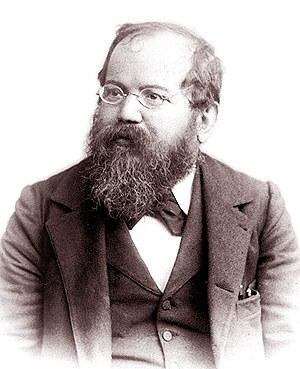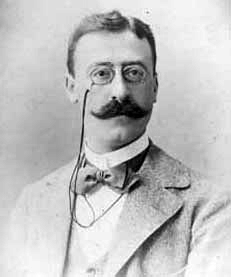
A world's fair, also known as a universal exhibition or an expo, is a large global exhibition designed to showcase the achievements of nations. These exhibitions vary in character and are held in different parts of the world at a specific site for a period of time, typically between three and six months.

William Steinitz was a Bohemian-Austrian and, later, American chess player. From 1886 to 1894, he was the first World Chess Champion. He was also a highly influential writer and chess theoretician.

The 1900 Summer Olympics, today officially known as the Games of the II Olympiad and also known as Paris 1900, were an international multi-sport event that took place in Paris, France, from 14 May to 28 October 1900. No opening or closing ceremonies were held. They were the very first Summer Olympics ever held in a non-leap year until the 2020 Summer Olympics, which were delayed to 2021 due to the COVID-19 Pandemic.

The Exposition Universelle of 1855, better known in English as the 1855 Paris Exposition, was a world's fair held on the Champs-Élysées in Paris, France, from 15 May to 15 November 1855. Its full official title was the Exposition Universelle des produits de l'Agriculture, de l'Industrie et des Beaux-Arts de Paris 1855. It was the first of ten major expositions held in the city between 1855 and 1937. Nowadays, the exposition's sole physical remnant is the Théâtre du Rond-Point des Champs-Élysées, designed by architect Gabriel Davioud, which originally housed the Panorama National.

The Exposition Universelle of 1900, better known in English as the 1900 Paris Exposition, was a world's fair held in Paris, France, from 14 April to 12 November 1900, to celebrate the achievements of the past century and to accelerate development into the next. It was the sixth of ten major expositions held in the city between 1855 and 1937. It was held at the esplanade of Les Invalides, the Champ de Mars, the Trocadéro and at the banks of the Seine between them, with an additional section in the Bois de Vincennes, and it was visited by more than fifty million people. Many international congresses and other events were held within the framework of the exposition, including the 1900 Summer Olympics.
Leonard William Barden is an English chess master, writer, broadcaster, journalist, organizer and promoter. The son of a dustman, he was educated at Whitgift School, South Croydon, and Balliol College, Oxford, where he read modern history. Barden learned to play chess at age 13 while in a school shelter during a World War II German air raid. Within a few years he became one of the country's leading juniors. Barden represented England in four Chess Olympiads. He played a major role in the rise of English chess from the 1970s. Barden is a chess columnist for various newspapers. His column in London's Evening Standard is the world's longest-running daily chess column by the same author.
Mephisto was the name given to a chess-playing "pseudo-automaton" built in 1876. Unlike The Turk and Ajeeb it had no hidden operator, instead being remotely controlled by electromechanical means.

Jacques Mieses was a German-born British chess player. He was one of the inaugural recipients of the title International Grandmaster from FIDE in 1950. He became a naturalized British citizen after World War II.p258

The Exposition Universelle of 1867, better known in English as the 1867 Paris Exposition, was a world's fair held in Paris, France, from 1 April to 3 November 1867. It was the second of ten major expositions held in the city between 1855 and 1937. A number of nations were represented at the fair. Following a decree of Emperor Napoleon III, the exposition was prepared as early as 1864, in the midst of the renovation of Paris, marking the culmination of the Second French Empire. Visitors included Tsar Alexander II of Russia, a brother of the King William and Otto von Bismarck of Prussia, Prince Metternich and Franz Josef of Austria, Ottoman Sultan Abdülaziz, and the Khedive of Egypt Isma'il.

A chess tournament is a series of chess games played competitively to determine a winning individual or team. Since the first international chess tournament in London, 1851, chess tournaments have become the standard form of chess competition among serious players.
World exhibitions became a new phenomenon in the West in the nineteenth century. Scientific and technical progress were shown. About a dozen World Fairs were organised during the second half of the nineteenth century. Seven times an international invitation chess tournament was part of the event. The third tournament took place in the Grand Cercle, 10 boulevard Montmartre, Paris, from 4 June to 11 July. Thirteen participants played in a double round-robin tournament. Draws counted as zero. The time control was ten moves an hour.
The Vienna 1873 chess tournament was a side event of the world exhibition of 1873.

The London Chess Classic is a chess festival held at the Olympia Conference Centre, West Kensington, London. The flagship event is a strong invitational tournament between some of the world's top grandmasters. A number of subsidiary events cover a wide range of chess activities, including tournaments suitable for norm and title seekers, junior events, amateur competitions, simultaneous exhibitions, coaching, and lectures.

The Brussels International Exposition of 1910 was a world's fair held in Brussels, Belgium, from 23 April to 1 November 1910. This was just thirteen years after Brussels' previous world's fair. It received 13 million visitors, covered 88 hectares and lost 100,000 Belgian francs.

The 1904 Cambridge Springs International Chess Congress was the first major international chess tournament in America in the twentieth century. It featured the participation of World Champion Emanuel Lasker, who had not played a tournament since 1900 and would not play again until 1909. After the tournament Lasker moved to America and started publishing Lasker's Chess Magazine, which ran from 1904 to 1907. However, that was not the only chess magazine spawned by the tournament. The Daily Bulletins produced by Hermann Helms proved so popular that Helms started the American Chess Bulletin as a direct consequence of the tournament. Volume 1, Issue 1 of the magazine was devoted to Cambridge Springs. Helms was somewhat more successful than Lasker as a publisher and American Chess Bulletin would be edited and published by Helms from 1904 until his death in 1963. The surprising upset victory of Frank Marshall marked his rise to prominence in American chess and he would eventually reign as champion of the United States for twenty-six years.
The Grand Chess Tour (GCT) is a circuit of chess tournaments where players compete for multiple prize pools. Major tournaments that have been featured in the Grand Chess Tour include Norway Chess, the Sinquefield Cup, and the London Chess Classic.

Mexico participated in the Universal Exhibition of Paris in 1900, on August 25 of that year. The theme that Mexico chose for its pavilion was modernity and the country's pre-Hispanic roots. The government of Porfirio Díaz wanted to show a facet of the country.
 Emanuel Lasker (German Empire)
Emanuel Lasker (German Empire) Harry Nelson Pillsbury (United States)
Harry Nelson Pillsbury (United States) Frank James Marshall (United States)
Frank James Marshall (United States) Géza Maróczy (Hungary)
Géza Maróczy (Hungary) Amos Burn (England)
Amos Burn (England) Mikhail Chigorin (Russian Empire)
Mikhail Chigorin (Russian Empire) Carl Schlechter (Austria-Hungary)
Carl Schlechter (Austria-Hungary) Georg Marco (Austria-Hungary)
Georg Marco (Austria-Hungary) Jacques Mieses (German Empire)
Jacques Mieses (German Empire) Jackson Whipps Showalter (United States)
Jackson Whipps Showalter (United States) Dawid Janowski (France)
Dawid Janowski (France) James Mason (United States)
James Mason (United States) Miklós Bródy (Austria-Hungary)
Miklós Bródy (Austria-Hungary) Leon Rosen (United States)
Leon Rosen (United States) James Mortimer (United States)
James Mortimer (United States) Manuel Márquez Sterling (Cuba)
Manuel Márquez Sterling (Cuba) M. Didier (France)
M. Didier (France)










